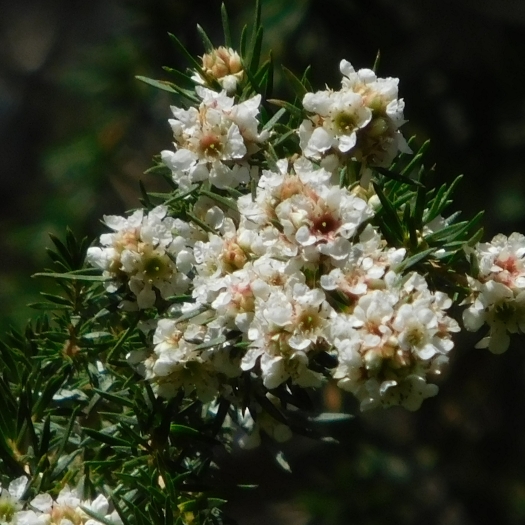Juniper Myrtle
(Taxandria juniperina)
Juniper Myrtle (Taxandria juniperina)
/
/

© Stephen Thorpe
CC BY 4.0
Image By:
© Stephen Thorpe
Recorded By:
Copyright:
CC BY 4.0
Copyright Notice:
Photo by: © Stephen Thorpe | License Type: CC BY 4.0 | License URL: http://creativecommons.org/licenses/by/4.0/ | Uploader: stephen_thorpe | Publisher: iNaturalist |

























Estimated Native Range
Summary
Taxandria juniperina, commonly known as the Juniper Myrtle or Wattie, is a perennial shrub or small tree native to the wetlands and swamp margins of the southwestern corner of Western Australia, particularly from Busselton to Waychinicup. It is part of the Myrtaceae family and thrives in winter-wet areas, often reaching up to 89 feet tall in its natural habitat. The Juniper Myrtle has fibrous brown bark and narrow, linear leaves that emit a spicy fragrance when crushed, which can add sensory interest to a garden setting.
The plant is notable for its white flowers tinged with pink, which bloom prolifically from February to November, providing extended visual interest. The flowers are not particularly showy but are valued for their subtle beauty and long flowering season. In cultivation, Taxandria juniperina is appreciated for its adaptability to various soil types, though it prefers moist conditions. It is often used for revegetation projects, as a windbreak, or in ornamental water-wise gardens due to its tolerance of wet conditions. Gardeners should provide it with full sun to part shade and ensure the soil has good drainage to mimic its natural swampy habitat. While it is generally low-maintenance, it can be susceptible to root rot if drainage is poor.CC BY-SA 4.0
The plant is notable for its white flowers tinged with pink, which bloom prolifically from February to November, providing extended visual interest. The flowers are not particularly showy but are valued for their subtle beauty and long flowering season. In cultivation, Taxandria juniperina is appreciated for its adaptability to various soil types, though it prefers moist conditions. It is often used for revegetation projects, as a windbreak, or in ornamental water-wise gardens due to its tolerance of wet conditions. Gardeners should provide it with full sun to part shade and ensure the soil has good drainage to mimic its natural swampy habitat. While it is generally low-maintenance, it can be susceptible to root rot if drainage is poor.CC BY-SA 4.0
Plant Description
- Plant Type: Shrub, Tree
- Height: 6-20 feet
- Width: 6-12 feet
- Growth Rate: Moderate
- Flower Color: White
- Flowering Season: Spring
- Leaf Retention: Evergreen
Growth Requirements
- Sun: Full Sun, Part Shade
- Water: High, Aquatic
- Drainage: Slow, Standing
Common Uses
Bird Garden, Erosion Control, Water Garden
Natural Habitat
Wetlands and swamp margins
Other Names
Common Names: Swamp Tea-tree, Juniper Myrtle
Scientific Names: , Taxandria juniperina, Agonis juniperina,
GBIF Accepted Name: